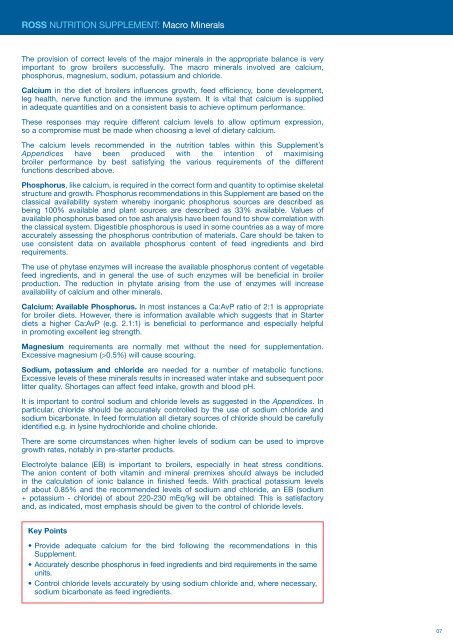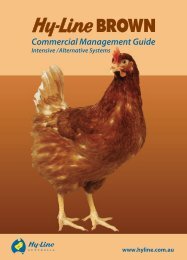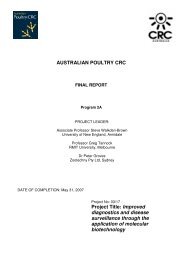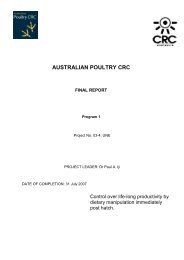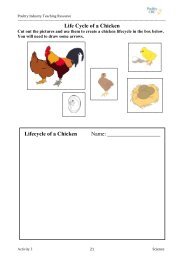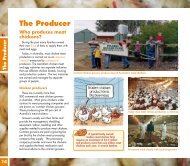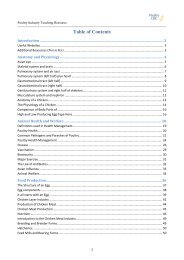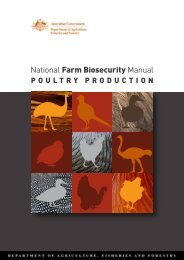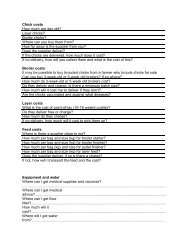Ross Broiler Nutrition Supplement - Poultry Hub
Ross Broiler Nutrition Supplement - Poultry Hub
Ross Broiler Nutrition Supplement - Poultry Hub
You also want an ePaper? Increase the reach of your titles
YUMPU automatically turns print PDFs into web optimized ePapers that Google loves.
ROSS NUTRITION SUPPLEMENT: Macro Minerals<br />
The provision of correct levels of the major minerals in the appropriate balance is very<br />
important to grow broilers successfully. The macro minerals involved are calcium,<br />
phosphorus, magnesium, sodium, potassium and chloride.<br />
Calcium in the diet of broilers influences growth, feed efficiency, bone development,<br />
leg health, nerve function and the immune system. It is vital that calcium is supplied<br />
in adequate quantities and on a consistent basis to achieve optimum performance.<br />
These responses may require different calcium levels to allow optimum expression,<br />
so a compromise must be made when choosing a level of dietary calcium.<br />
The calcium levels recommended in the nutrition tables within this <strong>Supplement</strong>’s<br />
Appendices have been produced with the intention of maximising<br />
broiler performance by best satisfying the various requirements of the different<br />
functions described above.<br />
Phosphorus, like calcium, is required in the correct form and quantity to optimise skeletal<br />
structure and growth. Phosphorus recommendations in this <strong>Supplement</strong> are based on the<br />
classical availability system whereby inorganic phosphorus sources are described as<br />
being 100% available and plant sources are described as 33% available. Values of<br />
available phosphorus based on toe ash analysis have been found to show correlation with<br />
the classical system. Digestible phosphorous is used in some countries as a way of more<br />
accurately assessing the phosphorus contribution of materials. Care should be taken to<br />
use consistent data on available phosphorus content of feed ingredients and bird<br />
requirements.<br />
The use of phytase enzymes will increase the available phosphorus content of vegetable<br />
feed ingredients, and in general the use of such enzymes will be beneficial in broiler<br />
production. The reduction in phytate arising from the use of enzymes will increase<br />
availability of calcium and other minerals.<br />
Calcium: Available Phosphorus. In most instances a Ca:AvP ratio of 2:1 is appropriate<br />
for broiler diets. However, there is information available which suggests that in Starter<br />
diets a higher Ca:AvP (e.g. 2.1:1) is beneficial to performance and especially helpful<br />
in promoting excellent leg strength.<br />
Magnesium requirements are normally met without the need for supplementation.<br />
Excessive magnesium (>0.5%) will cause scouring.<br />
Sodium, potassium and chloride are needed for a number of metabolic functions.<br />
Excessive levels of these minerals results in increased water intake and subsequent poor<br />
litter quality. Shortages can affect feed intake, growth and blood pH.<br />
It is important to control sodium and chloride levels as suggested in the Appendices. In<br />
particular, chloride should be accurately controlled by the use of sodium chloride and<br />
sodium bicarbonate. In feed formulation all dietary sources of chloride should be carefully<br />
identified e.g. in lysine hydrochloride and choline chloride.<br />
There are some circumstances when higher levels of sodium can be used to improve<br />
growth rates, notably in pre-starter products.<br />
Electrolyte balance (EB) is important to broilers, especially in heat stress conditions.<br />
The anion content of both vitamin and mineral premixes should always be included<br />
in the calculation of ionic balance in finished feeds. With practical potassium levels<br />
of about 0.85% and the recommended levels of sodium and chloride, an EB (sodium<br />
+ potassium - chloride) of about 220-230 mEq/kg will be obtained. This is satisfactory<br />
and, as indicated, most emphasis should be given to the control of chloride levels.<br />
Key Points<br />
• Provide adequate calcium for the bird following the recommendations in this<br />
<strong>Supplement</strong>.<br />
• Accurately describe phosphorus in feed ingredients and bird requirements in the same<br />
units.<br />
• Control chloride levels accurately by using sodium chloride and, where necessary,<br />
sodium bicarbonate as feed ingredients.<br />
07


